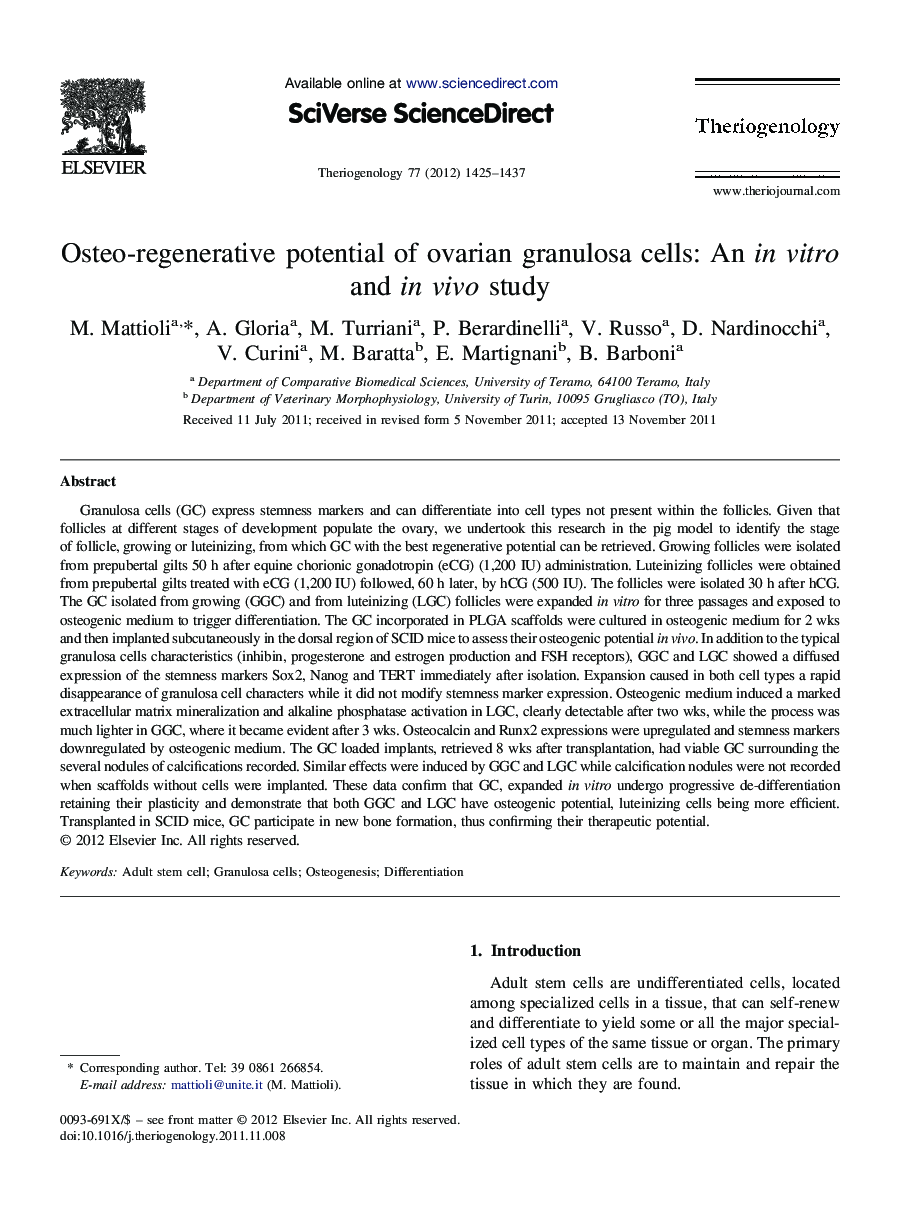| کد مقاله | کد نشریه | سال انتشار | مقاله انگلیسی | نسخه تمام متن |
|---|---|---|---|---|
| 10892341 | 1082099 | 2012 | 13 صفحه PDF | دانلود رایگان |
عنوان انگلیسی مقاله ISI
Osteo-regenerative potential of ovarian granulosa cells: An in vitro and in vivo study
دانلود مقاله + سفارش ترجمه
دانلود مقاله ISI انگلیسی
رایگان برای ایرانیان
کلمات کلیدی
موضوعات مرتبط
علوم زیستی و بیوفناوری
علوم کشاورزی و بیولوژیک
علوم دامی و جانورشناسی
پیش نمایش صفحه اول مقاله

چکیده انگلیسی
Granulosa cells (GC) express stemness markers and can differentiate into cell types not present within the follicles. Given that follicles at different stages of development populate the ovary, we undertook this research in the pig model to identify the stage of follicle, growing or luteinizing, from which GC with the best regenerative potential can be retrieved. Growing follicles were isolated from prepubertal gilts 50 h after equine chorionic gonadotropin (eCG) (1,200 IU) administration. Luteinizing follicles were obtained from prepubertal gilts treated with eCG (1,200 IU) followed, 60 h later, by hCG (500 IU). The follicles were isolated 30 h after hCG. The GC isolated from growing (GGC) and from luteinizing (LGC) follicles were expanded in vitro for three passages and exposed to osteogenic medium to trigger differentiation. The GC incorporated in PLGA scaffolds were cultured in osteogenic medium for 2 wks and then implanted subcutaneously in the dorsal region of SCID mice to assess their osteogenic potential in vivo. In addition to the typical granulosa cells characteristics (inhibin, progesterone and estrogen production and FSH receptors), GGC and LGC showed a diffused expression of the stemness markers Sox2, Nanog and TERT immediately after isolation. Expansion caused in both cell types a rapid disappearance of granulosa cell characters while it did not modify stemness marker expression. Osteogenic medium induced a marked extracellular matrix mineralization and alkaline phosphatase activation in LGC, clearly detectable after two wks, while the process was much lighter in GGC, where it became evident after 3 wks. Osteocalcin and Runx2 expressions were upregulated and stemness markers downregulated by osteogenic medium. The GC loaded implants, retrieved 8 wks after transplantation, had viable GC surrounding the several nodules of calcifications recorded. Similar effects were induced by GGC and LGC while calcification nodules were not recorded when scaffolds without cells were implanted. These data confirm that GC, expanded in vitro undergo progressive de-differentiation retaining their plasticity and demonstrate that both GGC and LGC have osteogenic potential, luteinizing cells being more efficient. Transplanted in SCID mice, GC participate in new bone formation, thus confirming their therapeutic potential.
ناشر
Database: Elsevier - ScienceDirect (ساینس دایرکت)
Journal: Theriogenology - Volume 77, Issue 7, 15 April 2012, Pages 1425-1437
Journal: Theriogenology - Volume 77, Issue 7, 15 April 2012, Pages 1425-1437
نویسندگان
M. Mattioli, A. Gloria, M. Turriani, P. Berardinelli, V. Russo, D. Nardinocchi, V. Curini, M. Baratta, E. Martignani, B. Barboni,